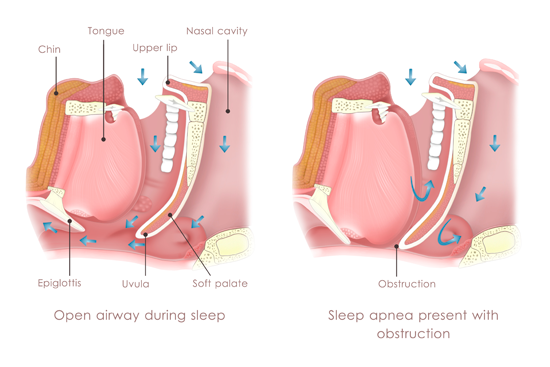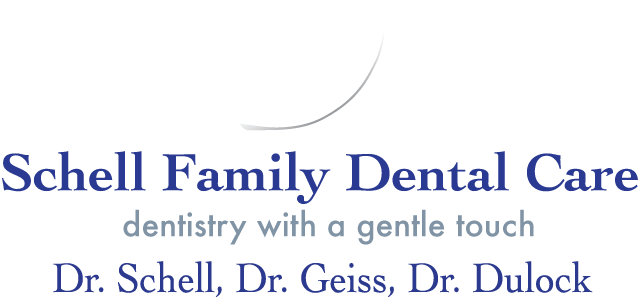Sleep Apnea & Snoring
Our office has been helping those with obstructive sleep apnea syndrome (OSAS) for quite some time. Dr. Schell is Board liaison to the research committee of the AADSM and has been involved in an NIH funded study to research obstructive sleep apnea. He has also sat on an experts consensus panel defining oral appliance therapy and authored a paper published in the JDSM and currently co-chairs an experts consensus panel on side effects of Oral Appliance Therapy. In addition, our staff travels and trains extensively in this area of medicine, regularly attending national SLEEP conferences and specialized educational sessions all over the country.
Obstructive sleep apnea syndrome is a serious disease and without treatment can lead to life-threatening complications.
What Causes Obstructive Sleep Apnea?
 Obstructive sleep apnea occurs when the muscles in the back of your throat that support the tonsils, tongue and uvula (the triangular piece of tissue hanging from the soft palate) relax. When this occurs, the throat airway narrows or closes, causing your breathing to momentarily stop and often lowering the level of oxygen in your blood. Sensing your inability to breathe briefly, your brain rouses you from sleep, so you can reopen your airway. This awakening is usually so brief that you don’t remember it.
Obstructive sleep apnea occurs when the muscles in the back of your throat that support the tonsils, tongue and uvula (the triangular piece of tissue hanging from the soft palate) relax. When this occurs, the throat airway narrows or closes, causing your breathing to momentarily stop and often lowering the level of oxygen in your blood. Sensing your inability to breathe briefly, your brain rouses you from sleep, so you can reopen your airway. This awakening is usually so brief that you don’t remember it.
The shortness of breath cycle continues through the night, often accompanied by snorting, choking or gasping sounds. The sleep disruptions impair your ability to sleep restfully, resulting in a state of drowsiness during your waking hours. Ironically, many people with sleep apnea believe they sleep well at night.
The chronic deep sleep deprivation affiliated with sleep apnea can cause many psychological and physical symptoms–while also causing dangerous sleepiness during the day. This regular ‘suffocation’ throughout the night signals a panic reaction; adrenaline and other stress hormones are released; the side effects of these are wide ranging; from anxiety and depression, inability to lose weight, blood sugar imbalance, impotence, memory and attention disturbances, a release of free radicals and others.
Sleep apnea is often detected by other household members or by the patient’s own awareness of the other symptoms. Irregular heartbeats, heart attack, high blood pressure, history of stroke, congestive heart failure can all be a direct or indirect result of this risky condition.
Diagnosis and Treatment
Only a physician can diagnose sleep apnea. The diagnostic test used is an overnight sleep study called a polysomnogram (PSG). This test gives detailed information on brain and muscle activity during sleep as well as the number of partial and complete pauses in breathing. Once a diagnosis of sleep apnea has been made, your physician will discuss your treatment options and help you decide which is best for you. Treatment includes Continuous Positive Airway Pressure (CPAP), Oral Appliance Therapy (OAT), surgery or a combination of these options.
What Is the Difference Between Snoring and Sleep Apnea?
Snoring
Snoring is the sound you hear when a snorer inhales during sleep. The noise occurs when the soft tissue at the back of the throat, the muscles that line the airway, and the tongue muscles relax causing the airway to narrow. As air passes through this narrow airway, it moves faster and causes the tissues to vibrate against each other producing a rattling or snoring sound.
Habitual snoring occurs in 40% of adults over age 40. An estimated 10-12% of children snore, often due to crowding of the airway from enlarged tonsils and adenoids. Overweight adults and children tend to snore more because there is more fat tissue in the neck and throat area which narrows the airway. You may be able to reduce snoring by behavioral changes. Losing weight can decrease the severity of snoring, as can avoiding alcohol, drugs, muscle relaxers, and tobacco products. Substances that relax your throat muscles, increase nasal congestion or create mucous in the throat all affect the size of your airway. Changing your sleeping position often helps too. Sleeping on your side or stomach puts less pressure on the airway than sleeping on your back.
Loud and habitual snoring can cause disrupted sleep for both the snorer and the snorer’s sleeping partner. It leads to daytime sleepiness and fatigue and can result in serious health problems. Normal, smooth, unobstructed breathing is the key to getting a restful night’s sleep.
Obstructive Sleep Apnea
Obstructive sleep apnea occurs when the soft tissue in a person’s throat repeatedly collapses and blocks the airway during sleep. These partial reductions and complete pauses in breathing last from ten seconds to one minute and can happen hundreds of times a night. Most people with sleep apnea snore loudly with periods of silence when airflow is reduced or blocked. They often make choking, snorting or gasping sounds when the airway reopens. The sleep disorder worsens with age and weight gain.
Common Signs of Sleep Apnea
• chronic daytime sleepiness
• restless sleep
• loud snoring
• periodic stoppage of breathing
• waking from sleep gasping for breath
• difficulty concentrating
• morning headaches
Diagnosis
Only a physician can diagnose sleep apnea. The diagnostic test used is an overnight sleep study called a polysomnogram (PSG). This test gives detailed information on brain and muscle activity during sleep as well as the number of partial and complete pauses in breathing. Once a diagnosis of sleep apnea has been made, your physician will discuss your treatment options.

